After finishing second in the WSL last season, two points behind Chelsea Women, Manchester City Women have not lived up to pre-season expectations, winning one and losing one of their league games so far (they lost just one league game in total last season), and they were knocked out of the Champions League before the group stages by debutants Real Madrid Femenino.
This nightmare start, as some have labelled it, has led to questions surrounding Gareth Taylor’s future at the club, but we need to give them time to improve, for a couple of reasons. Firstly, they had 13 players featuring for their countries at the Tokyo Olympics during the summer, with four playing in the final, and opted not to play a pre-season friendly to give those players as much recovery time as possible. Secondly, they currently have a sizeable injury list, with first-team regulars Caroline Weir, Ellie Roebuck, Keira Walsh, Karen Bardsley, Lucy Bronze, Chloe Kelly and Esme Morgan all on the sidelines, as well as new signing Hayley Raso and club captain Steph Houghton, with the latter sustaining an ankle injury during the recent England camp.
This tactical analysis will look at the reasons for their struggles, from a tactical point of view. The scout report will focus on their attacking and defensive play, as well as their decision-making, providing analysis on where they need to improve as the season goes on.
Attacking problems
Manchester City Women’s attacking tactics last season revolved around playing through the thirds, as well as using the wings to stretch opposing defences out. This allowed the central striker to run through the gaps and meet balls coming into the box, as well as opening up the half-spaces for the two forward midfielders to position themselves in. As a result, they scored 65 goals in their 22 league games last season, only four less than Chelsea, and averaged 64.12% of possession.

However, in their recent game against Tottenham Hotspur Women, they were unable to play this way. Tottenham set up in a 4-4-2 structure, indicated by the white lines, with the aim of sitting back and preventing Manchester City playing through the thirds. Their narrow structure left the wings wide open, intentionally, with Manchester City forced to play in those areas instead. The ball had a greater distance to cover when passed out there, which gave Tottenham time to get back and set up defensively whenever Manchester City did look to attack down the wings.
Manchester City struggled to adapt to this style of play, which brings us to the first problem; they only have one way of playing. When opposing teams prevent them playing the way they like to, as Tottenham did here, they are made to look ordinary and very beatable. Therefore, devising a backup structure is something they need to do not only to rediscover their form but also to really challenge for the league title.
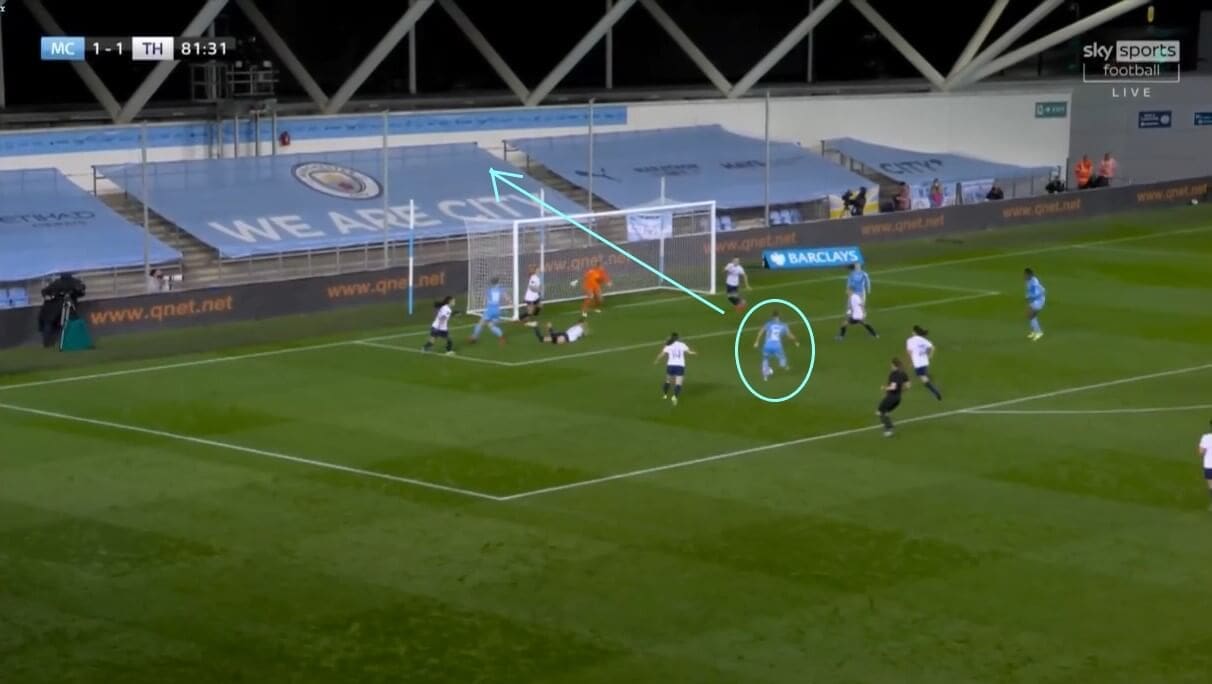
When Manchester City crossed the ball into the box, Tottenham controlled their airspace and continually cleared the ball. However, on the rare occasion that Manchester City did win the ball behind the defence, they wasted the opportunities. This image shows one example of this, with Sweden midfielder Filippa Angeldal, who joined the club on transfer deadline day, sending her effort high over the bar. This was not the only time that this happened, as Canada forward Janine Beckie had also missed a close-range opportunity in the first half.
Not taking their opportunities has been a common theme in all of their games so far this season, and is something Gareth Taylor has spoken about at length, knowing that it is costing them in key moments. Improving their conversion rate will undoubtedly help them to regain their confidence, and could be all that is needed to get them back on track.
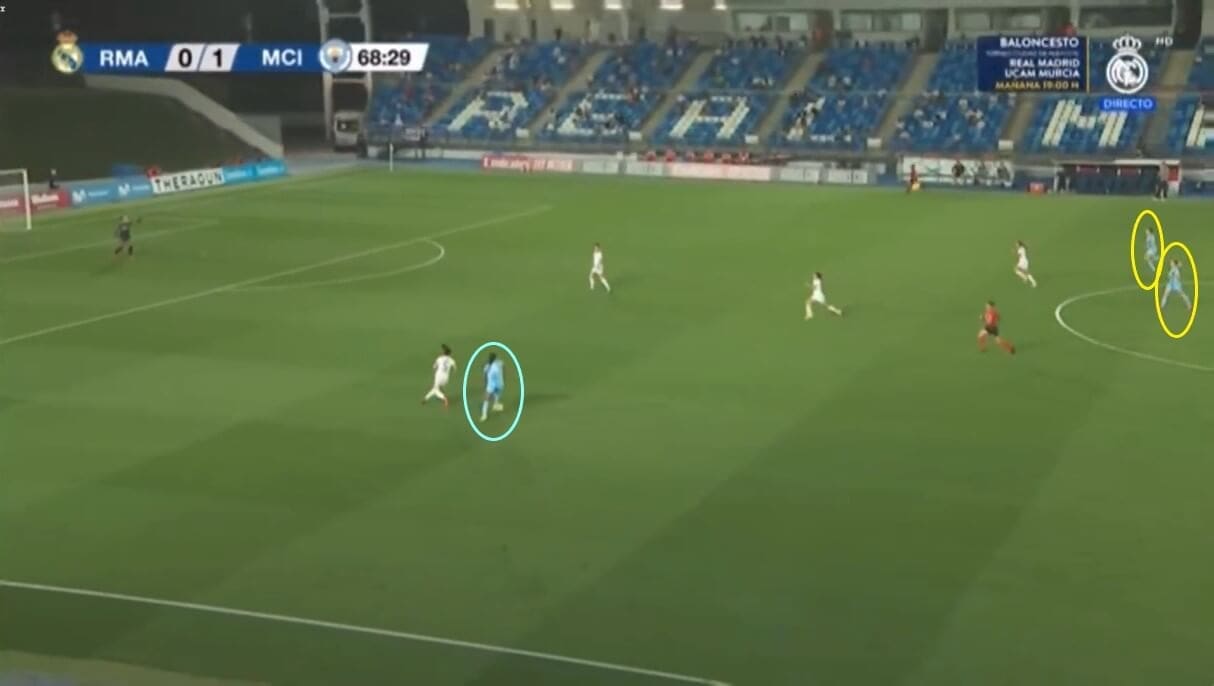
Another problem they have had in attack is a lack of passing options. Here, in the first leg of their Champions League qualifier against Real Madrid, Khadija Shaw has taken the ball into the attacking half, leading a counter-attack for her side. However, as the yellow circles show, the Jamaica striker’s teammates have not advanced at the same pace, so there are no passing options for her to find, meaning that Manchester City have lost their attacking momentum. Their communication and teamwork in these situations needs to be better, as Real Madrid were allowed to get back and block off the spaces here, whereas Manchester City could have had a shot at goal if they had got forward quicker.
Defensive issues
In defence, Manchester City Women’s biggest problem has been leaving spaces open for opponents to exploit.
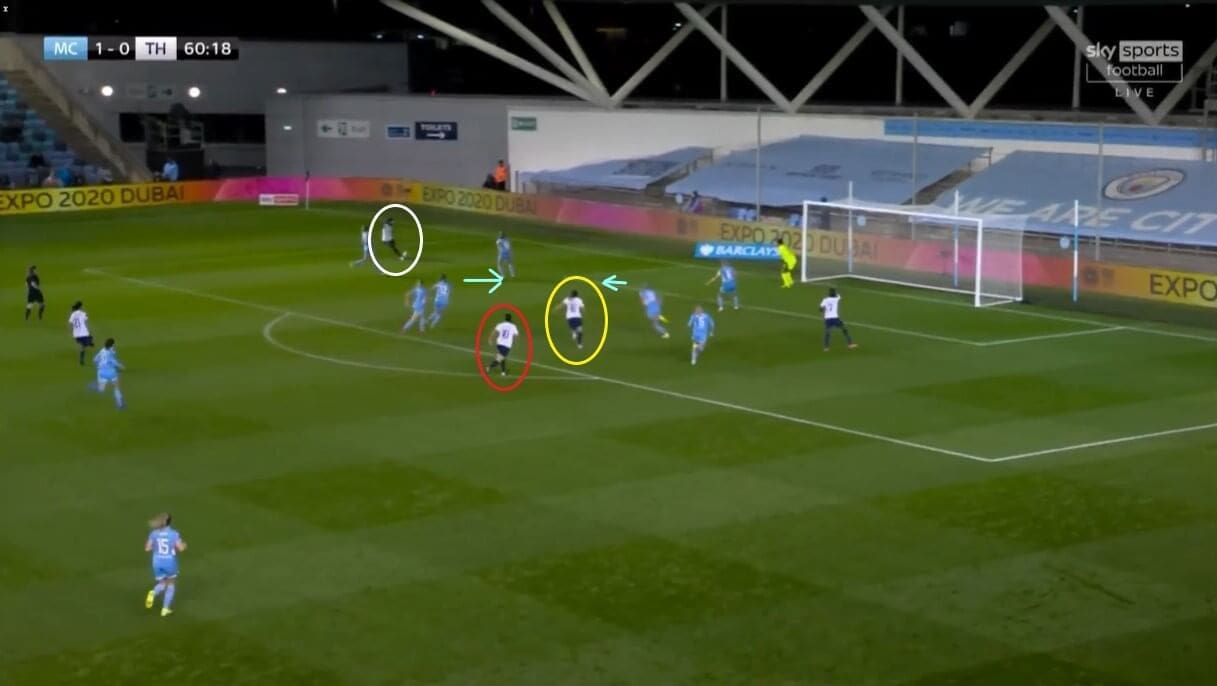
Here, we see the build-up to Tottenham’s equaliser at the Academy Stadium. Former Real Madrid striker Chioma Ubogagu has taken the ball to the far side of the box, before dragging it back into the middle. Kit Graham has run towards the ball, with Manchester City all looking to close her down, as the blue arrows show. However, she is only a decoy, and the defenders’ movements to close her down creates gaps in the box, which allows former Birmingham City Women striker Rachel Williams to slot the ball into the net. Manchester City last season won 68.9% of their defensive duels, but have only won 61.2% this time around, so improving this will help them to be more watertight at the back.
There are a couple of things to note here. Firstly, as mentioned, both sides of the Manchester City defence moved towards Graham, assuming incorrectly that she was the target, so their communication and teamwork again needed to be better. Secondly, the space should not have been left open for Graham to move into initially, as the Manchester City players needed to come together to close the gap between the two lines, which would have made it harder for Ubogagu to pass the ball in. Ultimately, although the winning goal was a handball by Rosella Ayane, the equaliser could have been prevented.
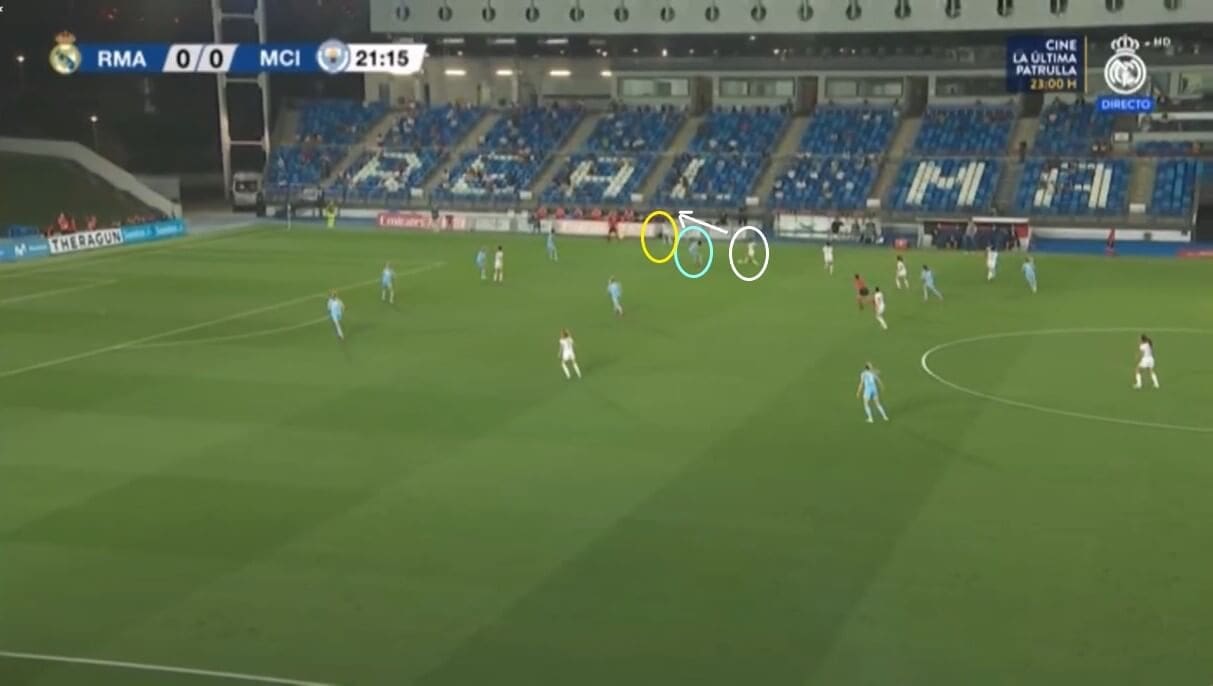
Manchester City also tend not to close the ball down in their own third, as is shown in this image. Real Madrid are looking to attack forwards, and Manchester City could have prevented them doing so by closing down the player in possession. Instead, by staying back, they allowed Real Madrid to make the pass, leading to a shot on goal only a few passes later. It may seem like a small detail, but games turn on moments like this. Manchester City lack decisiveness at times, with their opponents often given the space to play around them and maintain their forward momentum, so this is something else that needs improving.
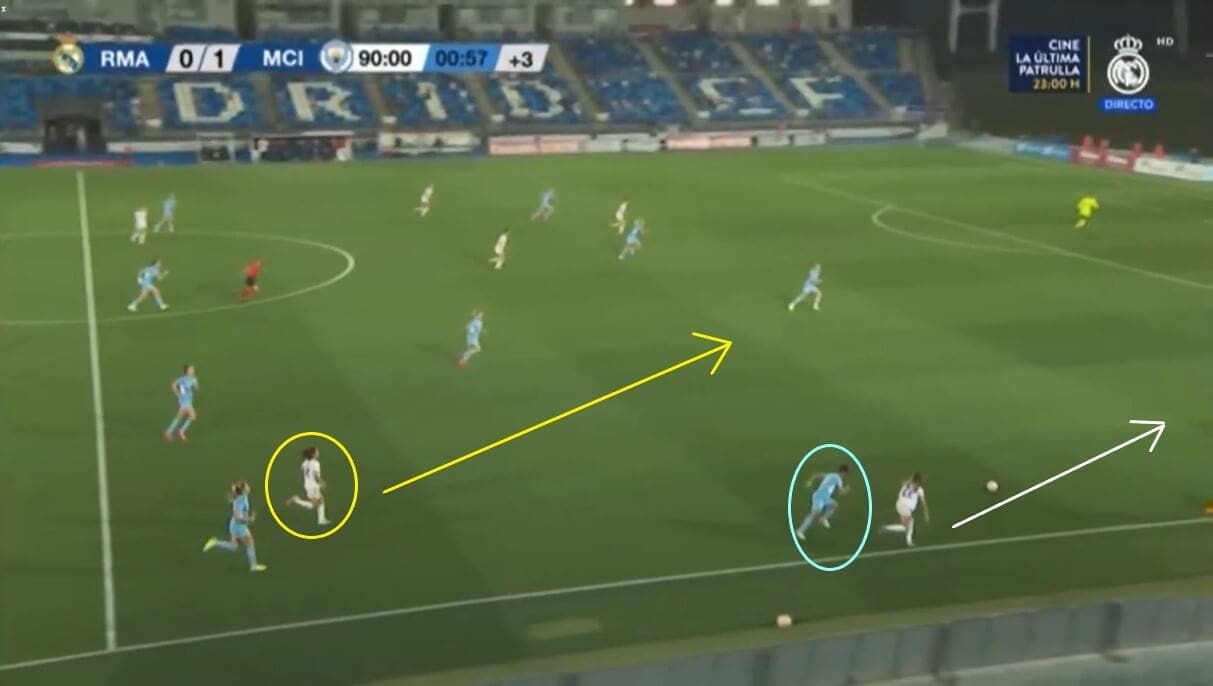
This image shows another defensive mistake, with England left-back Demi Stokes stepping up to close the ball down. This time, it was the wrong decision to do this, as it opened up the space behind, whereas there was cover behind in the previous image, so closing the ball down was the correct option to take. Stokes’ inability to win the ball allows Real Madrid forward Athenea del Castillo to move around her and into that space, as the white arrow shows.
This mistake leads to Real Madrid’s equaliser, scored by Mexico right-back Kenti Robles. Robles, in the yellow circle, has a gap to run through as a result of Stokes coming out of line and drifting away from the rest of the defenders, so Manchester City’s defensive struggles have simply been the result of errors like this which have cost them in key moments.
Decision-making
We have analysed Manchester City Women’s attack and defence, picking out the areas where they are going wrong at the moment, but the key thing that they have struggled with is their decision-making across all areas of the pitch.
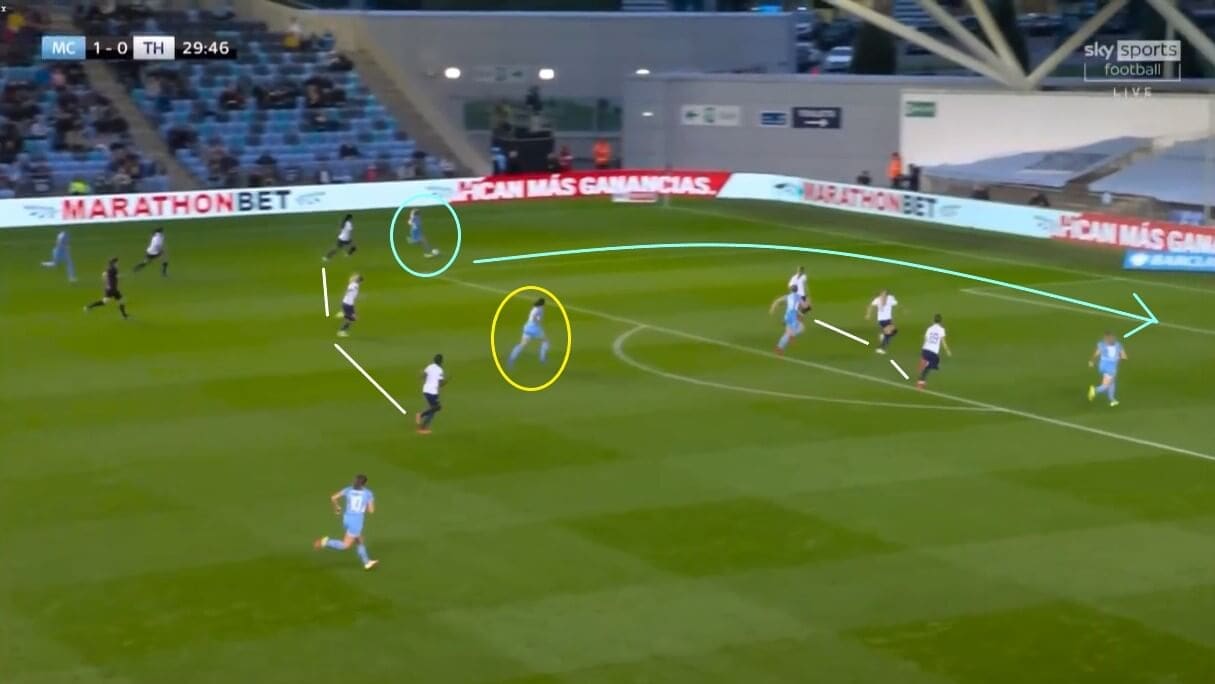
We have already mentioned how Manchester City only know one way of playing, and that is highlighted again in this image. Lauren Hemp has the ball on the far side of the pitch, and is crossing it into the box here, aiming for the space between the defence and the goalkeeper. However, none of her teammates are able to connect with it, due to Tottenham’s defenders working together to keep them out.
There was a better passing option for the England winger here though, as Tottenham had left a gap between the two ranks, with a Manchester City player positioned in that space. Had Hemp passed there instead, Manchester City might have been able to find a way to break down Tottenham’s organised defence, so this once again comes down to a lack of communication and awareness.
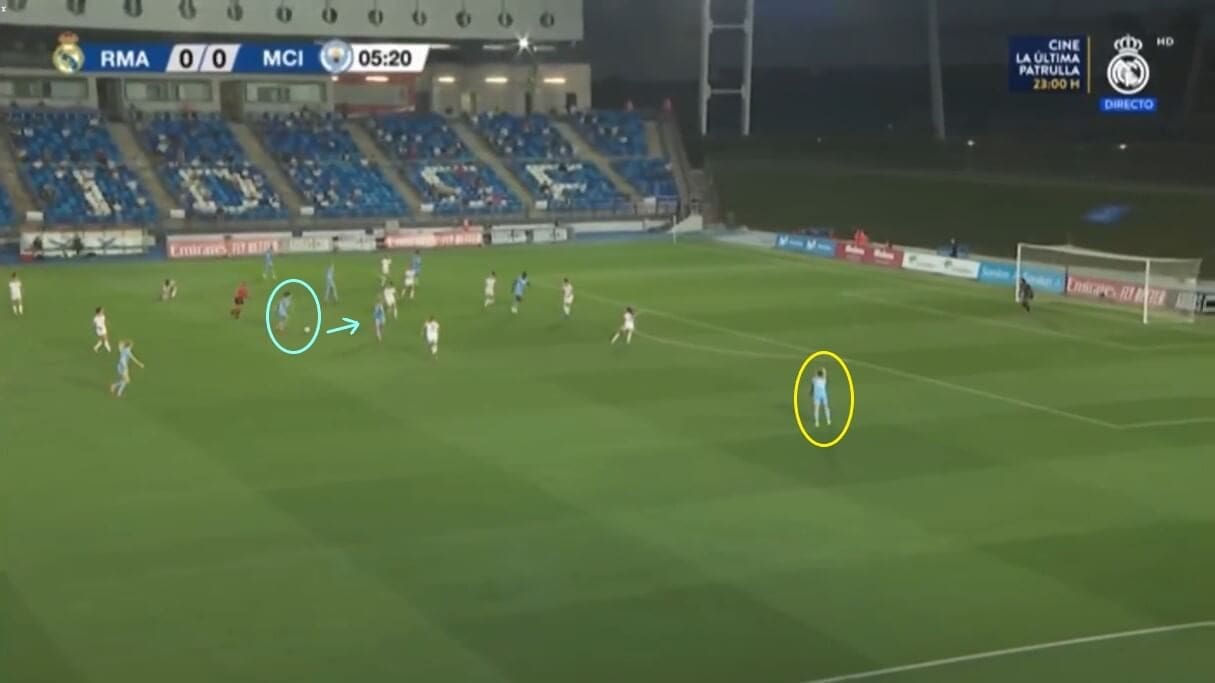
The issue with not using the best passing option is also demonstrated in this image. Real Madrid have narrowed up, just as Tottenham did, trying to force Manchester City to play the ball out wide. However, whilst there is a passing option in open space, in the yellow circle, ready to receive the ball, it is instead passed centrally, allowing Real Madrid to block and clear it.
Therefore, again, Manchester City have lost their forward momentum when in a good attacking position. When they did get back to recover the ball and rebuild their attack, the player who was in space had been closed down by the Real Madrid players, meaning that Manchester City had wasted the opportunity. Again, this comes down to them needing better awareness of what is happening around the pitch, which is something they have undoubtedly struggled with so far this season.
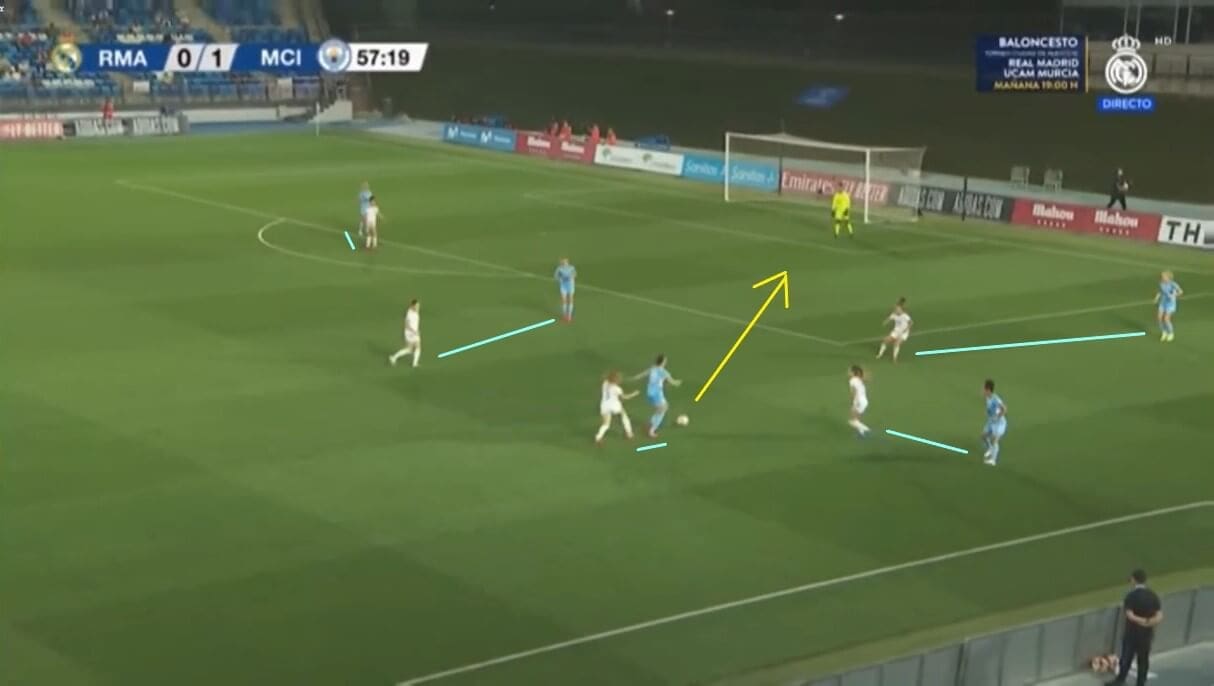
Arguably their biggest issue with decision-making has been playing out from the back. As mentioned, Gareth Taylor likes his team to play through the thirds, which is where their 4-3-3 structure comes in. However, Real Madrid were alive to this, closing down each Manchester City defender in turn here, meaning that the player currently in possession has no viable passing options available to them, and is instead forced to pass backwards under pressure from their own marker. However, the pass is too short, with Real Madrid collecting it and having a shot at goal.
This situation emerged from Manchester City opting to play short passes around their goal area, rather than clearing the ball, and this again stems from them only knowing one way of playing. Therefore, this is something they need to work on, as it happened a few times in this game, and they were lucky not to concede more goals.
Conclusion
In conclusion, Manchester City Women’s problems are not major, but are simply minor issues that can be fixed on the training ground. Before judging them too harshly, it should be remembered that both they and Everton Women added plenty of new players over the summer, and both have so far struggled to get going this season. The reason that Manchester City are getting more attention over this is because they are one of the top three in the league, and they exited the Champions League earlier than expected. However, if they can sort these problems out, gel in their new additions and regain their match sharpness after no pre-season fixtures, then they will very quickly begin to climb the WSL table again.





Comments